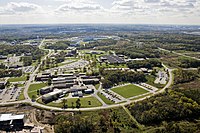
Photo from wikipedia
We present the design, pedagogical logic, and assessment of a laboratory and supporting materials that integrate a clinical academic cardiologist's understanding of the origins of the electrocardiogram (ECG) with a… Click to show full abstract
We present the design, pedagogical logic, and assessment of a laboratory and supporting materials that integrate a clinical academic cardiologist's understanding of the origins of the electrocardiogram (ECG) with a physics educator's insights into how to teach the underlying physics at the introductory level to life science students. In this article, we explain the choices made throughout the design process, connect a more advanced treatment of the physics to our approach, and present our assessment of the curriculum. Before the laboratory, students learn the cellular origins of the electric dipole potential produced by the heart on the body's surface, including a simple physical model for the electrical activity of excitable cells, and learn to interpret the measured voltages of an ECG as probing components of the heart's time-varying electric dipole moment. In the laboratory, students measure their own ECGs and analyze the data accordingly; they animate their data to display their own heart's dipole moment for a single heartbeat. Our results from the assessment of student understanding and attitudes indicate that although students find the content challenging, nearly all students find it at least moderately interesting, and for about a quarter of the students in the course, this lab plays a highly meaningful part in connecting physics to medicine.
Journal Title: American Journal of Physics
Year Published: 2020
Link to full text (if available)
Share on Social Media: Sign Up to like & get
recommendations!